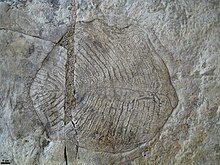Cephalozoa
| Cephalozoa Temporal range: Ediacaran
| |
|---|---|

| |
| Fossil of Yorgia waggoneri, a cephalozoan found on the shores of the White Sea. | |
| Scientific classification | |
| Domain: | Eukaryota |
| Kingdom: | Animalia |
| Phylum: | †Proarticulata |
| Class: | †Cephalozoa Ivantsov, 2004 |
| Subtaxa | |
Cephalozoa[1] are an extinct class of primitive segmented marine organisms within the Phylum Proarticulata from the Ediacaran period. They possessed bilateral symmetry and were characterized by a thin, rounded body.
Description
[edit]
Unlike the other classes of proarticulates, the segmentation of the body is not complete and shows a "head" with fine distribution channels. Some species of the Yorgiidae family also show some asymmetry.[3][4][5]
They were discovered in Russia near the White Sea in the Arkhangelsk region, where they lived during the Ediacaran, approximately 635 to 540 Ma (millions of years ago).
Taxonomy
[edit]Cephalozoa includes the families Yorgiidae and Sprigginidae:
Yorgiidae
[edit]- † Archaeaspinus Ivantsov, 2007 (synonym of Archaeaspis)
- † Archaeaspinus fedonkini Ivantsov, 2001
- † Yorgia Ivantsov, 1999
- † Yorgia waggoneri Ivantsov, 1999
Sprigginidae
[edit]- † Spriggina Glaessner, 1958
- † Spriggina floundersi Glaessner, 1958
- † Spriggina ovata Glaessner and Wade, 1966 now considered synonym of Marywadea ovata.
- † Marywadea Glaessner, 1976
- † Marywadea ovata Glaessner and Wade, 1966
- † Cyanorus Ivantsov, 2004
- † Cyanorus singularis Ivantsov, 2004
- † Praecambridium Glaessner and Wade, 1966, previously classified as Yorgiidae; now considered a juvenile form of Spriggina[6]
- † Praecambridium sigillum Glaessner and Wade, 1966
The genus Andiva is sometimes included in Cephalozoa:

- Andiva Fedonkin, 2002
- Andiva ivantsovi Fedonkin, 2002
Recent studies indicate that the family Yorgiidae could be included or closely related to the class Vendiamorpha.[7]
See also
[edit]References
[edit]- ^ a b Ivantsov, A. Y. (2001). "Vendia and Other Precambrian "Arthropods"". Paleontological Journal. 35 (4): 335–343.
- ^ Fedonkin, Mikhail A. (2007). The Rise of Animals: Evolution and Diversification of the Kingdom Animalia. Baltimore (Md.): JHU Press. ISBN 978-0-8018-8679-9.
- ^ Ivantsov, A. Yu (2004). "New Proarticulata from the Vendian of the Arkhangel'sk Region" (PDF). Paleontological Journal. 38 (3): 247–253.
- ^ Ivantsov, A. Y.; Malakhovskaya, Y. E.; Serezhnikova, E. A. (2004). "Some Problematic Fossils from the Vendian of the Southeastern White Sea Region" (PDF). Paleontological Journal. 38 (1): 1–9. Archived from the original (PDF) on 2007-07-04. Retrieved 2021-08-11.
- ^ Ivantsov, A. Y. (2004). Vendian Animals in the Phylum Proarticulata (PDF) (Thesis). Prato, Italy: The Rise and Fall of the Vendian Biota. IGSP Project 493. Abstracts. p. 52.
- ^ Ivantsov, Andrey Yu (2007). "Small Vendian transversely Articulated fossils". Paleontological Journal. 41 (2): 113–122. Bibcode:2007PalJ...41..113I. doi:10.1134/S0031030107020013.
- ^ "Vendiamorpha". Paleobiology Database. Retrieved 17 December 2021.

